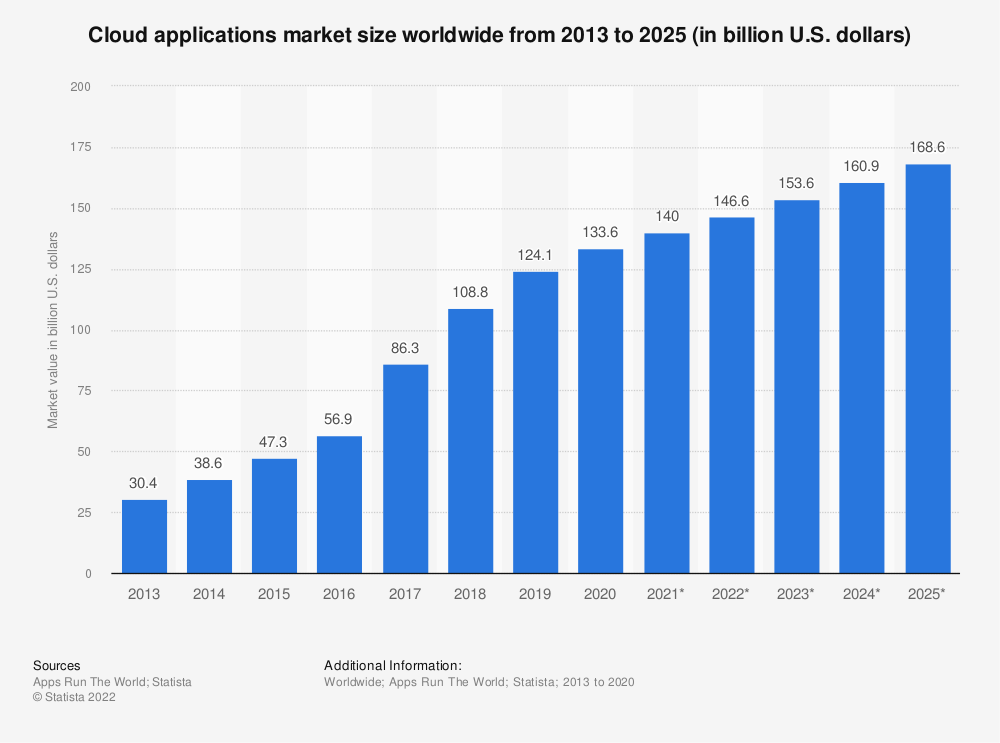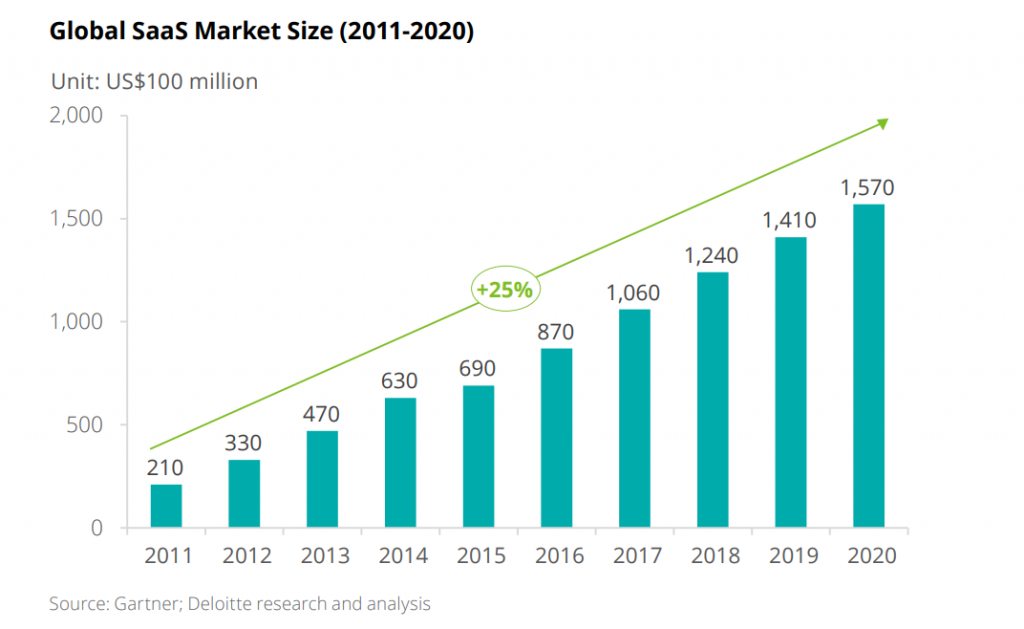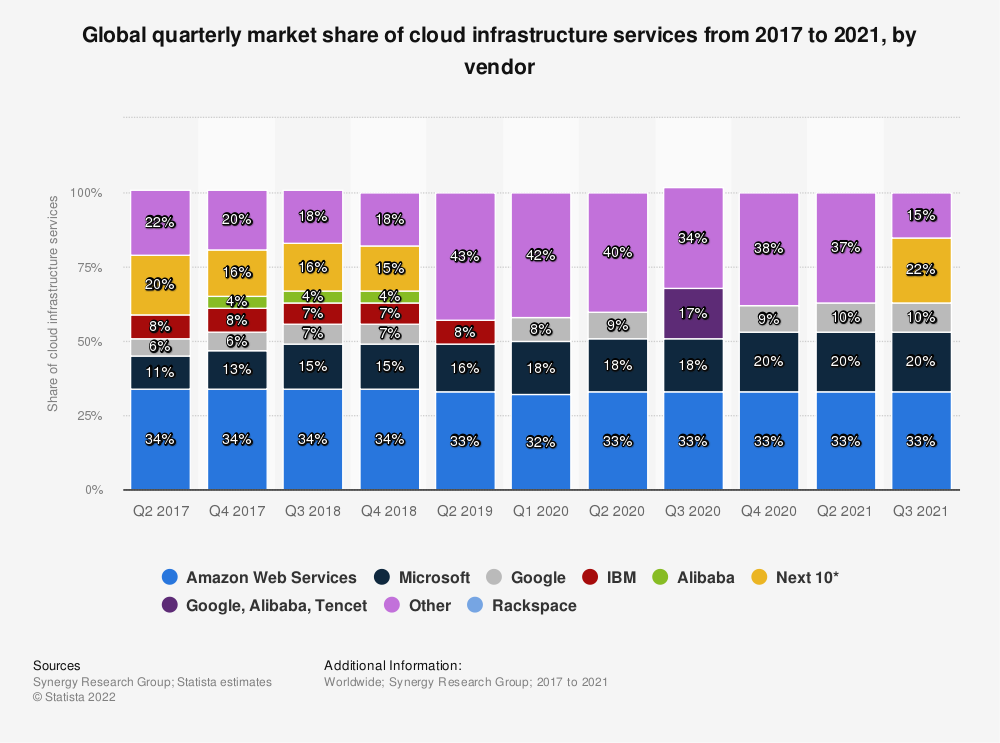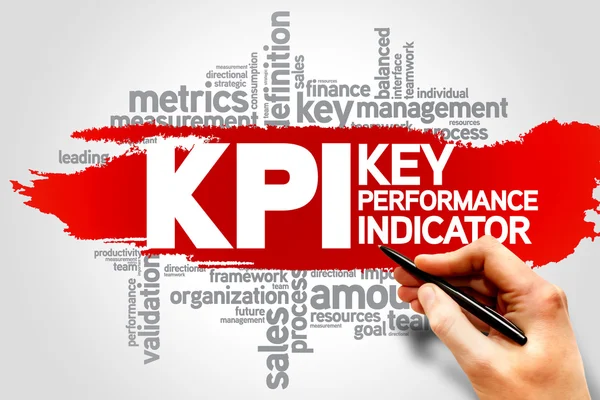Being young, innovative and trustworthy, cloud computing enjoys ever growing popularity in today’s global world. The very term “cloud computing” means availability of computer system resources, computing power, data storage on demand without any active management involved. This allows the businesses to minimize their IT infrastructure costs and concentrate directly on their business aims.
You may come across information about 3 types of cloud computing services:
- IaaS (Infrastructure-as-a-service)
- PaaS (Platform-as-a-service)
- SaaS (Software-as-a-service)
In this article, we’re going to focus on SaaS as a successful and promising business model and cover various aspects of the SaaS business.
Hop on reading to learn more about SaaS
1. What is the SaaS business model?
2. A bit of history and statistics of SaaS businesses
3. Comparing business models: SaaS business model vs. traditional business
4. Peculiar features of a successful SaaS business
5. Key stages of SaaS business development strategy
6. SaaS business model KPIs or SaaS metrics
7. Saas business model: challenges SaaS founders face
What is the SaaS business model?
The term SaaS (Software-as-a-service) means distributing cloud-based and centrally hosted software to users on a subscription basis. However, this term is mostly used by professionals in the e-commerce and IT spheres. Instead of SaaS software or SaaS product, most people would also use such terms as online software, web-based software, or on-demand software, which accurately describe its nature. Any company that maintains its software on a cloud and licenses it to users through a subscription plan, whether monthly or annual (those are the two most common options), can be called a SaaS company. Among the most noted companies are Amazon web services, Google, Slack, Zoom, Netflix, Adobe Creative Cloud, Shopify, Hubspot, Microsoft, Zapier, Miro and the list goes on.
The SaaS business model substantially simplifies the process of using software. Instead of buying and installing specific hardware and software and renewing the software license, the users can simply buy a subscription and get all the benefits of using a SaaS product. This type of access to software obviously decreases IT spending for both individuals and companies.
A bit of history and statistics of SaaS businesses
While it may seem that the very idea of SaaS is a bit over a decade and a half old, in fact, the concept of centralized hosting of business software dates back to the 1960s. At that time, banks and some other large organizations and businesses used to acquire computing power and database storage from computer provider data centers (IMB, for example). Such services were called time-sharing or utility computing.
The 1990s saw a new kind of centralized computing-ASP (application service provider) due to Internet expansion. The main aim of ASPs was to provide businesses with hosting and managing third-party business applications, while successful SaaS companies and SaaS development services today host and manage their own software products.
Since the 2000s, the SaaS business has experienced exponential growth, with lots of startups emerging and significantly changing some business spheres.
The SaaS business market reached $152 bn in 2021, and it‘s now estimated to reach $ 208 bn by 2023. The number certainly exceeds the projected ones that are mentioned in the graph below, which means that SaaS business is on the scale of expansion beyond expectations. If we look at the period of 10 years on the graph below, we clearly spot a fivefold growth of SaaS as a model of running a business, at the very least.

According to the Deloitte report “SaaS Industry Outlook: Time to ride the wave,” dated November 2021, the global SaaS business industry has been undergoing a rapid development phase accompanied by continuous innovation of products and business models. Over the past ten years, the global SaaS business market size registered a compound annual growth rate of 25%.

The following graph shows some of the most significant players or successful SaaS businesses, where 1/3 of the market share belongs to Amazon web Services.

Comparing business models: SaaS business model vs. traditional business
While the traditional model has been the norm for many years, the emergence of SaaS has obviously revolutionized the way businesses operate and deliver their products or services. Let’s explore the characteristics of both models and highlight their key differences.
Business model: traditional
The traditional model has long been the cornerstone of commerce. In this model, businesses typically create a physical product or offer a tangible service that is sold directly to customers. These businesses often have a brick-and-mortar presence, such as retail stores, offices, or manufacturing facilities. Revenue is generated through one-time sales, recurring purchases, or service contracts. Traditional businesses often require substantial upfront investments in infrastructure, inventory, and employees. They may rely on physical distribution channels and face challenges such as limited scalability and geographical constraints.
Business model: SaaS business
On the other hand, SaaS has gained significant traction as a business model in recent years, particularly in the software industry. SaaS businesses provide software applications or services that are accessible over the internet. Instead of selling a physical product, they offer a cloud-based solution that customers can access through a subscription or pay-as-you-go model. This allows users to access the software from anywhere, using any device with an internet connection. SaaS typically handles maintenance, updates, and data security on behalf of their customers. This model offers flexibility, scalability, and cost-effectiveness, as it eliminates the need for customers to invest in hardware or software infrastructure.
Key differences
One key difference between the traditional model and the SaaS model lies in revenue generation. Traditional businesses often rely on one-time sales or recurring purchases, while SaaS businesses generate recurring revenue based on selling a cloud-based software for a subscription fee. This recurring revenue stream provides greater predictability and stability for SaaS.
Another significant distinction is the level of investment required. Traditional businesses typically require substantial upfront investments in physical assets, inventory, and infrastructure, while SaaS businesses can operate with relatively lower capital requirements. This makes SaaS a more attractive option for startups and entrepreneurs looking to enter the market with minimal financial resources.
Scalability is also a differentiating factor. Traditional businesses may face challenges when it comes to scaling their operations, especially if they rely on physical distribution channels. In contrast, SaaS businesses can easily scale their services to accommodate growing customer demands as they operate in the digital realm.
Peculiar features of a successful SaaS business
Successful SaaS development companies boast the following peculiar features that distinguish them from other business models:
- High customer retention
- Consistent updates
- Recurring payments
If you’re interested in marketing for SaaS companies, you’ll need to understand the following features and how to promote them to your audience.
High customer retention
The SaaS business strategy must be focused on offering innovative services that breed long-term relationships and also upselling simply because it’s the crux of keeping such businesses afloat.
Signing up new customers should be followed by turning them into loyal clients with the help of spotless customer service. Poor customer service, on the contrary, may discourage SaaS business clients even if the very product they provide is outstanding.
Consistent updates
One of the benefits of the SaaS model for the customers is that SaaS firms invest a significant part of their resources in consistent updates of the software product they sell. It’s quite obvious that updating the software you host in the cloud is much easier than delivering upgrades and new versions to the customers who have installed the software on their personal devices. SaaS businesses understand the value of the security of their clients’ data as well as the necessity to provide their clients with top-notch SaaS solutions. So frequent updates, new features, and applications are the strategy that helps SaaS businesses keep every customer happy and satisfied.
Recurring payments (SaaS pricing model)
SaaS revenue models are based on selling cloud-based software for a subscription fee. Consequently, the clients of SaaS have to make sure they purchase a monthly or annual subscription, compared to buying software once and installing it on their device. As a result, SaaS businesses get monthly recurring revenue (MRR) based on a monthly subscription model. It’s worth noting though that a SaaS business normally gets paid upfront, and the notion of revenue is based on the concept of money earned. It means a customer may claim their payment back if dissatisfied with the service. Thus, revenue recognition might be problematic for SaaS businesses (still, the revenue model helps you understand how to profit from your SaaS business). With that in mind, a reliable SaaS accounting tool is one of the best investments for the SaaS business.
Key stages of SaaS business development strategy
Practically every SaaS business follows the same model or stages during its business life. It’s vital to understand what stage your company is at as it can help avoid ungrounded decisions which can eventually lead to failure. This idea may sound even more convincing if we remember that 90% of all startups fail. According to the specialists at Investopedia, this number can be further broken down to 21.5% of startups that fail in the first year, 30% in the second year, 50% in the fifth year, and 70% in their 10th year.
To get a better understanding of the process, let’s take a brief look at the main stages of the SaaS business, such as Pre-startup, Startup, Growth, and Maturity.
Pre-startup
According to the specialists at Chargify (the company that helps SaaS businesses manage their recurring revenue customers), pre-startup may be referred to as discovery or vision stage and characterized by:
- trying to spot the problem and finding a viable software-driven solution
- looking for financial support from family and friends
- studying and researching the problem
- building relationships with potential clients, mentors, advisors
- making up a SaaS business plan
- joining an accelerator group
- making a product (initial stage)
According to Andrew Armstrong, founder of KickStart Search, the common risks at this stage are:
- “failure to design a business plan and strategy that will enable the company to become profitable
- a dependency on seed money to cover operational costs for a longer period than anticipated
- a lack of funds to cover rising employee and infrastructure costs”.
Startup
Startup stage, also known as validation or product/market fit stage, has a name that speaks for itself. At this stage the SaaS business model focuses on:
- honing the product and its key features
- implementing analytics to track SaaS metrics
- proceeding with key hires
- finding product/market fit
- getting first customers
- securing investments (angel/seed money)
The most common risks, according to AndrewThe key SaaS risks, according to Andrew Armstrong, at this stage would be:
- inability to get the number of customers that can create the cash flow needed to fund operations
- failure to deliver the necessary volume of products or services
- making hiring mistakes
Growth
According to the specialists at Chargify, at the growth stage some companies realize the necessity “to shift focus from revenue growth to profitability”. This stage is marked by the following activities:
- increase of sales volume or revenue
- expanding the market share and becoming profitable
- refining the service based on market feedback
- seeking new funding to support customer acquisition and scaling
- hiring more professionals (including executives)
The major risks management should be aware of at this stage as defined by Andrew Armstrong are related to:
- inability to keep the company stable and profitable
- expanding into oversaturated markets
- developing new products that turn to be unpopular at the cost of the company’s reserves
Maturity
Maturity stage is also known under the name expansion stage. It’s explained by the fact that after reaching a certain desired proportion of the market, the company normally seeks new markets, possibly new products and channels of distribution.
At this stage the company may:
- look for additional funding to support its expansion
- develop new products and services
- hire personnel to cater to new needs
- restructure some processes
- go global
- consider IPO opportunities
The biggest risks at this stage would be:
- not accommodating the needs of the changing market
- losing the competitive edge
In short, understanding the key demands and potential risks of the SaaS business model at every stage may help to prevent premature scaling and make the company successful.
SaaS business model KPIs or SaaS metrics
When it comes to success, how exactly does one define whether a SaaS business is a successful one? And again, “successful” may mean a lot of things like “profitable”, “developing at a steady pace”, “well-known brand name”. That’s where good old KPIs come into play.
In his article on 7 important SaaS marketing KPIs, Chris Martin (the CMO of FlexMR, a hybrid research agency & tech firm that empowers brands with agile insight) argues that it’s vital to define which particular SaaS metrics are worth tracking.
His idea is that too many KPIs might lead to “analysis paralysis”, while tracking just one KPI can hardly be of any great value for defining a company’s growth opportunities. Chris Martin believes that the following 7 key KPIs should give you a reliable picture of any SaaS business model health.

Net profit
Net profit can be defined as the sum of business performance and it’s calculated as revenue minus expenses. So implementation of strategies and techniques that help increase net profit is undoubtedly supported by the management.
CAC
CAC (Customer Acquisition Cost) equals the cost of getting a new customer. CAC is calculated by dividing total marketing and sales costs by the number of clients obtained over a certain period of time. It also measures the effectiveness of marketing technologies (advertising for example).
CLV
Being one of the main metrics for any business, CLV (Customer Lifetime Value) helps prioritize the most valuable clients, personalize campaigns and offers and analyze the value of customer acquisition channels. It’s calculated the following way: average customer value multiplied by average customer tenure. The CLV-to-CAC ratio for a mature SaaS business model has to be between 2-to-1 and 8-to-1.
Monthly Recurring Revenue
MRR is calculated by multiplying average revenue per customer and total customers in a month. As SaaS revenue model is based on recurring fees from the customers, MRR analysis helps track monthly cash flow, which can hardly be overestimated.
Funnel Conversion Rates
This indicator shows how many of the people who entered your funnel actually convert into customers. FCR is calculated by dividing total conversions by total leads in the funnel (then multiplied by 100). This percentage shows which funnel stages have leaks and need more attention.
Net Promoter Score
NPS score is sometimes referred to as the gold standard in measuring growth potential and shows customer loyalty and satisfaction with your service. Tracking NPS starts with asking one question: “How likely are you to recommend us to your friends?” The answers are scaled 0 to 10. NPS is the percentage of customers who will promote the service, also known as promoters (scored 9-10) minus the percentage of detractors (scored 0-6). Chris Martin suggests adding a follow-up “Why?” as well, because these answers will give real feedback from the clients and great opportunities for improvement when it comes to detractors.
Churn Rate
Churn rate is one more indicator of customer satisfaction. It’s actually the rate at which your company loses clients over a certain period of time. A successful SaaS business is defined by churn rate that is lower than acquisition rate.
Saas business model: challenges SaaS founders face
A founder of a SaaS company might face multiple challenges managing a SaaS product as they embark on the journey of building and growing their businesses. At large, those challenges derive from the peculiarities of the business model. Let’s break them down and see how business owners can handle them.
Managing recurring revenue
One significant hurdle revolves around effectively managing subscription-based revenue streams. Unlike traditional businesses that rely on one-time purchases, SaaS companies rely on recurring revenue from subscriptions, which adds complexity to revenue forecasting, customer retention, and pricing strategies. Balancing the need to attract new customers while ensuring existing ones continue their subscriptions requires careful monitoring and strategic decision-making.
Balancing CAC
Another critical challenge for a SaaS company owner is tracking customer acquisition costs. Acquiring new customers often involves various marketing and sales efforts, such as content creation, advertising campaigns, lead generation, and sales team expenses. Determining the return on investment (ROI) for these activities and understanding which channels deliver the most cost-effective results can be daunting. Analyzing customer acquisition costs helps founders optimize their marketing strategies, allocate resources efficiently, and improve their overall customer acquisition efficiency.
Maintaining accurate financial records
Maintaining accurate financial records is yet another obstacle that SaaS product owners must tackle. As their businesses grow, the complexity of financial operations increases significantly. It includes tracking revenue from different pricing tiers, managing recurring billing cycles, handling refunds and cancellations, and ensuring compliance with accounting standards and regulations. Failing to maintain accurate and up-to-date financial records can lead to inefficiencies, errors in reporting, and potential legal and tax compliance issues.
Saas sales
Selling SaaS products poses a bunch of challenges. Founders need to educate potential customers, be patient during longer sales cycles, address concerns about security and support, determine optimal pricing, and focus on customer retention. Building a strong sales team, utilizing data analytics, and fostering customer relationships are key to overcoming these challenges and achieving sustainable growth.
If you want to explore the challenges of selling SaaS products deeper, and understand how you handle them efficiently, please read our article on Seven Ways to Improve Sales for a SaaS Business.
With the above said in mind, SaaS product owners might want to leverage the power that accounting software designed particularly for SaaS offers. Multiple solutions available on the market can cover some of the aspects of running such a business, such as managing accurate financial records and recurring payments. However, solutions that combine accounting with business analytics, such as Synder, for example, might be a much better fit for companies working under SaaS business models. This way, apart from the purely financial side of their business, they would be able to to track a variety of performance and behavioral indicators and critical SaaS metrics, helping them better understand the wellbeing of their business and identify bottlenecks and opportunities to grow.
If you believe Synder can be a solution for you, feel free to book office hours with our team to learn more about how it helps managing SaaS, or sign up for a free trial to explore Synder’s features and capabilities yourself.
Bottom line
The application of the SaaS business model is almost limitless. SaaS, as a model, works for both B2B and B2C segments successfully. Among the most noted companies are Amazon web services, Google, Slack, Zoom, Netflix, and more. While these companies provide different products in various spheres, convenience, cost-saving and higher security are the common features that attract their customers. From a business owner’s perspective, SaaS stands out because of its rapid growth, increased revenue, simplicity of deployment and great scalability. Taking these benefits into account, as well as fast expansion of subscription-based economy over the last decade and a half, the prediction that SaaS businesses are to thrive and flourish doesn’t come as a surprise.







.png)
